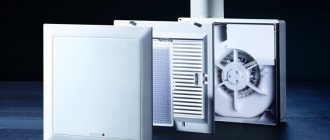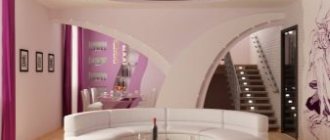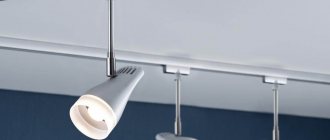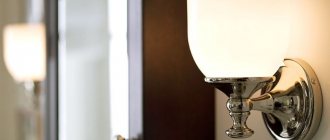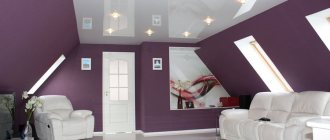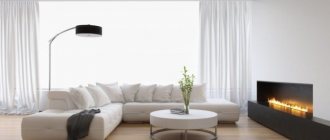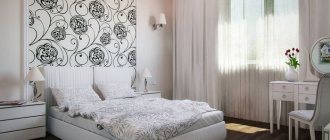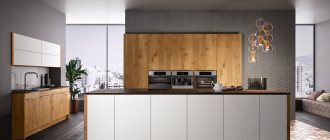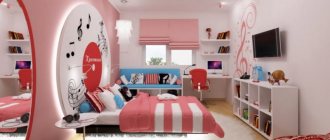Due to the adhesive base, the backlight must be secured in the baseboard channel and the wires must be routed to the power supply.
Upon completion of the installation process, the cable channel is closed using a matte acrylic profile or transparent strip.
Universal solutions
Today, spot systems are most often used to illuminate bathrooms and toilets. They are relatively inexpensive, fit into any design, and consume little. In general, some advantages. There are plenty to choose from: round or square, rotary and stationary, with and without pendants (shades), multi-colored and plain.
Moreover, to make spot lighting it is not at all necessary to have suspended ceilings; models are also offered with a socket located outside. By the way, they turn out to be even more effective than those built into the ceiling in terms of creating a uniform light flux.
Models with cartridges
In addition, once you set a goal, you will be able to handle their installation yourself. Just be responsible when choosing the brand of spotlights. Products must be of high quality and airtight - high humidity in the bathroom should not in any way affect their operation. Of course, they will cost you an order of magnitude more, but this is your safety!
Calculation of the required number of lamps
After choosing the type of lamp, you need to decide which lamps on the ceiling in the bathroom will be most optimal. Then it is important to correctly calculate the number of lighting elements. For this, the following is taken into account:
- Presence or absence of windows.
- Room area.
- Ceiling height.
- The need for zoning.
- Purpose of the premises. For bathrooms and living rooms, lamps differ in their characteristics.
For example. With a standard height of 2.80 m, one lamp is needed for every 1.5 - 2 meters. Therefore, for a room of 10 m², 5 - 6 pieces are installed. But it all depends on the presence of a chandelier and other lighting sources. At the same time, lamps on the ceiling in the bathroom can only be located in the washbasin area, and not above the shower stall or the bath itself.
Chandeliers – forever!
The usual ceiling lamps or chandeliers do not lose their relevance. The choice of model is made based on the scale of the room. Although often the initial parameters of showers (as well as toilets) greatly limit design possibilities. It is logical that a multi-tiered chandelier in a cramped room will look ridiculous. Flat, concise options are more appropriate here. And it's much easier to care for them.
Similar lamps are often installed on walls - this is very convenient. The illumination is carried out at the level you need. And at the same time, you do not create your own shadow, as is the case with ceiling lamps.
For these reasons, it makes more sense to install a pair of lamps so that the rays emanating from them intersect at the place where you most often stay while in the bathroom.
If the bathroom area and ceiling height allow, you can install any lighting fixture. Your choice is limited only to moisture-resistant models, adjusted for the location of use and design. And in the evening, with other light sources extinguished, a chandelier with such a luxurious carved shade will provide you with stunning light displays.
Custom bathrooms
In a small, combined bathroom, where you can’t even dream of a separate toilet, the best option would be either overhead spotlights that do not require a ceiling box for insertion, or compact wall sconces. You can install them without much difficulty with your own hands, given that the quantity will be minimal.
By and large, for a compact bathroom, two spots on the ceiling and a mirror with built-in or overhead lamps on the sides are quite enough.
The same applies to attic bathrooms. Often this room is small, with irregularly shaped ceiling planes. The specific layout also affects the lighting design. During the daytime there is enough light from the window, and in the evening lamps of all kinds come into play. And again, what is most appropriate here are sconces or spots that can be easily integrated into the ceiling.
Bath in the attic
Bathroom lighting scheme
Considering the type of room, the quality of lighting will depend on the correct location of light sources and the power of the selected lamps.
The correct organization of lighting for a bathroom is represented by the arrangement of lamps:
- spotlights or ceiling lamps provide overhead lighting (on the ceiling);
- spot and LED strips (duralight) are used for lower lighting, for room decoration (illumination of steps, bathtub pedestal).
spots and lampshades on the wall are used for auxiliary and working lighting, for zoning the room;
Based on the ISO 8995 bathroom lighting standard, it provides 200 lux (lux) of illumination. This standard takes into account both the characteristics of the room and the needs of the person, taking into account his psychological and physical state. Knowing the power of the LED lamp, the number of lamps is calculated, but taking into account the area of the room.
Alternative lighting
Very often, designers use the technique of illuminating the entire ceiling. Behind the inserts made of canvas, frosted glass or plastic are hidden rows of fluorescent lamps or strips of LEDs. Such lighting blocks can also be made on walls - thanks to this, the space also noticeably expands.
Another good option for a small bath is to use a mirror with a built-in lamp for lighting. Anyway, you can’t do without a mirror, but there’s not enough space taken up, and the functionality is quite decent.
Illuminated mirrors
It could just as well be a mirror cabinet with built-in LED strips.
A great trick is to install mirrors on opposite walls. By resorting to this little trick, you will expand the bathroom space and increase the illumination, without increasing the power of the lamps. Once inspired by an idea, you can make such a multifunctional piece of furniture with your own hands. To do this, you will need a base - a mirror, and a set of LEDs with a power supply, wires and a step-down transformer.
For any other room, you could get by with almost a ready-made Chinese garland, but in the bathroom only waterproof products of high quality assembly should be used. Water shorting is no joke.
LED Expansion
LEDs are the only systems that can provide absolutely safe and functional lighting in the bathroom. A diode light bulb can be so small that it can be successfully integrated into any surface of any height. It shines brighter and consumes the least energy. Often a combination of spots and LED strip is enough to get full, uniform lighting.
Also, LEDs on the stream and in niches help emphasize the unusual design with space zoning.
They use low voltage to operate, which means they can be safely installed near water - right under the side of the bathroom, for example. Of course, special, completely sealed systems are used for this.
Bathroom lamp: ceiling version
Depending on the size of the bathroom, the user's preferences and the activities performed in this room, you can use different types of lamps installed in certain areas. A ceiling lamp provides general lighting in the bathroom. In terms of design, the most common color here is white combined with chrome elements. This combination creates an impression of exceptional elegance and purity, making it suitable for almost any bathroom. Depending on your preferences, you can choose a vintage or rustic ceiling lamp to decorate the hygiene area.
LED lamps: advantages of choice ↑
LED lighting is now perhaps the strongest competitor to traditional incandescent lamps. LEDs are used everywhere in lighting all types of rooms. In the bathroom it becomes relevant. And this is no coincidence, because LED lighting has a number of exceptional advantages.
Pros ↑
- Cost-effective and high light output. The main advantage of LED lamps is that they shine very brightly, but at the same time consume extremely little energy. Light output can reach up to 120 lumens per watt, while a classic incandescent lamp can barely go beyond 10-24 lumens per watt. Agree, the difference is obvious. In the bathroom, the brightness of the lamps is the leading criterion, so LEDs definitely win here.
- Safety. On average, LED lamps operate at a voltage of 12 or 24 Volts, which is completely safe for humans. In view of this, they can be safely installed near water sources - above the bathtub, shower, next to the sink, etc. However, of course, this does not mean that you don’t have to worry about high-quality sealing during lighting installation and the general moisture resistance of the lamps.
Comparison of LED lamps with other types of lighting
- Huge service life. If we have to change ordinary lamps, even modern and energy-saving ones, with unpleasant frequency, then LED lamps will work uninterruptedly for a very long time. Approximately 50 times longer than incandescent lamps - up to 70,000 hours. This is almost 8 years of continuous round-the-clock work! This is why the installation of built-in LED lighting is so popular, where you will have to disassemble the structure in order to replace the lamp. After all, if comfortable conditions for the operation of the lamps are observed, it is unlikely that they will need to be changed at all before the next repair.
- Ability to change brightness. This is an extremely nice feature of LEDs for decorating a bathroom. Just imagine: in the morning you need to take a good look at yourself in the mirror, and you turn on the lamp to maximum brightness. But in the evening after work, turn down the brightness to soft, dim light and take a relaxing bath in the pleasant twilight. Great!
- Low temperature. LEDs don't get hot at all. Although this is not a key parameter, it is sometimes also pleasant - it is impossible to get burned by a burning LED lamp.
- Width of design solutions. First of all, LED lights are often interesting in their own right. For example, popular LED strips, the installation of which will take about 10 minutes, can fill a room with character without any extra investment. They often have multiple operating modes and color spectrums. Full-fledged wall and ceiling lamps based on LED lamps are also now being produced. There are a lot of options for external embodiment. And finally, speaking of design, one cannot fail to mention the technical capabilities of LEDs. The most popular option is spot lighting with spotlights, as well as built-in strip lighting.
Read more: Washing machine with an inverter motor: rating of models The variety of color possibilities with only one LED strip is amazing!
Cons ↑
However, along with the advantages, LEDs also have disadvantages, which, however, can be reconciled with.
- High price. Of course, quality cannot be completely cheap, so the price range for high-quality LED lighting is on average an order of magnitude higher than for incandescent or fluorescent lamps. At the same time, the price is fully justified by durability and quality.
- Eye strain. As already mentioned, LEDs have sufficient aperture. In addition, the light contains a blue spectrum, which can cause eye fatigue and increase vision strain. However, this drawback only manifests itself when constantly under bright LED lighting. It is unlikely that you will spend the whole day in the bathroom.
Advantages and disadvantages
LED lamps are gaining more and more popularity, relegating other sources of artificial light to the background. And use in the bathroom is almost irreplaceable due to the positive characteristics of the product.
The most important advantage of LED lighting is its efficiency. With high light output, there is a small electricity consumption (120 Lm/W, while an incandescent lamp can produce 10-24 Lm/W). And since in the bathroom there are almost always no windows with access to natural light, the quality of artificial lighting plays a leading role.
LED lighting in the bathroom
In humid conditions, the safety of electrical equipment is important. Since the LED lamp operates under a voltage of 12 or 24 V, even with possible contact with damaged wiring or the lamp itself, no harm will be caused to the body.
Such products are distinguished by their long service life, which is 50 times longer than incandescent lamps. Rough calculations show that the installed backlight will last about 8 years with continuous use.
This virtually eliminates the possibility of breakdown and the need for replacement. This is not always possible if the lighting points are located in hard-to-reach places or are mounted in such a way that replacement requires the integrity of any structure to be destroyed.
The lighting of a chandelier with an LED lamp can be adjusted to make it brighter or dimmed. This property is in demand for the average consumer, because sometimes you want to create a romantic atmosphere in the twilight or just give your eyes a rest after a long day of work at the computer monitor.
The big advantage of LED bathroom lighting is the low temperature during operation. More precisely, its absence, because the lamps do not heat up.
The popularity of LED lighting devices is explained by the breadth of design solutions, color spectrums and many operating modes. And today, full-fledged ceiling and wall lamps, which are equipped with such lamps, have begun to be actively produced.
The disadvantages include, first of all, the high cost of the product. Although, thanks to the long service life, we are talking about long-term savings.
Some users note that when they are under LED lighting for a long time, they feel strain on their eyes. Lamps cause fatigue and increase stress. But this drawback loses its relevance, even if LEDs are used in the bathroom as the main lighting. Stay in this room is limited to a short time frame.
Products with LEDs do not tolerate temperatures above 100°C, so their use in baths and saunas is impractical.
Installation rules
Wiring in the bathroom must be hidden. Ideally, it would be a copper cable with a cross section of 1.5 mm2.
When you install the wiring yourself, do not connect aluminum and copper cables directly, otherwise a short circuit will occur. Use special clamp adapter terminals or solder the twist, having first carefully soldered (insulated) the copper axis. Then seal the joints with heat shrink tubing.
The wiring to the lamps is under the ceiling covering, carried out only in corrugated sleeves. This will protect the cable from mechanical damage and will also prevent a spark from spreading during a short circuit. If you plan to install the spots yourself, follow the order of work. For ceilings with slatted coverings, you need to lay the wiring and attach the lamps gradually, as the slats are filled. For plasterboard and suspended ceilings, you first need to lay the wiring and screw the fasteners to the concrete base to which the lamp sockets will be connected. Then you need to mark the GC sheet or canvas.
When installing lamps, be sure to ground them.
Spotlights in interiors
To make your choice, you can look at photos of lamps in the bathroom. Various options show how you can diversify your design with a variety of lighting sources.
Different layout principles apply:
Bathroom design 6 sq.m. with washing machine and toilet- Scandinavian style bathroom design (60+ photos)
- Gray bathroom: design features, photos, best combinations
- Oval.
- Chaotic arrangement imitating the sky.
- Cross.
- Rectangle.
- Circle.
- Arc.
- Wave and others.
This needs to be taken into account
For each specific room, the number and power of lamps will vary.
The following formula is usually accepted: 20 watts per 1 meter of area. For modern low-power (but no less bright) light bulbs, you need to make a correction by dividing the result by 5.
When determining the number and power of lamps, you should also use a small correction for the color of the walls of the room. Light walls scatter light better, which means you can install lamps of lower power (we multiply the result by 0.8). If the bathroom design involves dark colors, the estimated number of lamps should be multiplied by 1.5. The result increases by the same amount if the ceilings are higher than 3 m. Also, the ceiling covering imposes certain restrictions on the use of lamps. The most sensitive to heat are plastic panels and PVC film sheets, lath and fabric coverings are less susceptible, followed by plasterboard structures and concrete ceilings themselves. For the first two coatings, LED, fluorescent and low-power halogen bulbs are allowed. For the latter, you can use any light bulbs, but of course, not placing them closer than 10 cm to the surface.
LED decorative lighting
Cons ↑
As a rule, LED lamps come in three main types:
- Spotlights. Spot-type lamps are small and cut directly into the surface. Typically, the design is a bright high-aperture lamp and a diffuse lens on top. Spotlights are installed by a whole group along an electrical chain. Very often you can find multi-mode operation of spot lighting. For example, you can turn on one group of all lamps, two groups, all lamps, etc. It is also often possible to dim – change the brightness of the lighting. They may have rotating reflectors, thanks to which you can adjust the direction of the light.
Variety of LED lamps and recessed spotlights
- LED LED strip. This is a flexible mounting strip board on which tiny but very bright LED bulbs are mounted. Typically, the tape is also protected by a transparent flexible casing that protects the board elements from mechanical damage.
There are a lot of options for LED strips. They differ in aperture ratio, number of lamps per meter of board, color temperature. Most often, ribbons have many color modes. However, some produce only pure concentrated colors - red, blue, green, etc., while others can create almost any shade in the RGB palette.
The special beauty of the tape is that most models have an adhesive layer on the back side. Therefore, installation is simple, quick and does not depend on your repair. There is no need to drill, install or provide anything separately for the tape. The tapes are sold by the meter; they also require control panels and a power supply that converts the voltage.
- Overhead and other lamps. In addition to strips and spotlights, LEDs can also be found in the form of more conventional lamps. Sconces, ceiling lamps similar to modern chandeliers, overhead spotlights with rotating mechanisms - all this is also available on the modern market.
High-tech chandelier option with LED lamps
The most popular option for basic LED lighting is spotlights. This way you can cover the entire bathroom space.
Spot lighting combined with targeted lighting creates harmony in space
A slightly more expensive, but very effective option is lighting the ceiling around the entire perimeter. This is done using LED strips with high brightness and high frequency LEDs (for example, 60-120 pieces per 1 meter). Pay special attention to this - the more bulbs per meter of strip, the brighter the light will be.
Usually the tape is installed in niches of multi-level ceilings or at the junction of the ceiling and wall. However, if your bathroom is very large, then lighting just around the perimeter may not be enough. In this case, you need to add another tape in the central area of the ceiling. It is better to choose a warm color spectrum that is closer to natural light and will not give the bathroom a feeling of surgical sterility.
Sometimes one strong tape is enough to cover the entire room
Spot and strip lighting are also sometimes combined. This is again appropriate in spacious bathrooms, in which there is room for design ideas to roam.
And finally, the simplest solution is ready-made lamps with LED lamps. Most often, they are made in high-tech style, but sometimes you can find more classic options. They are installed in the same way as other lamps. For a small bathroom, one large lamp will be enough. For larger rooms, choose several medium or spot overhead lighting.
This type of combined main lighting looks very impressive.
Target lighting ↑
Targeted lighting in the bathroom is a must. First of all, you need separate lighting for all mirrors in the bathroom. The easiest way to solve this issue is with an LED strip around the perimeter of the mirror. Moreover, it can be installed either directly on the wall or on the side walls of the mirror. In this case, you will have a light source pointed directly at you, so the reflection will be as detailed as possible.
Options for target mirror illumination
In addition to the mirror, additional lighting for the shower area, as well as built-in niches and cabinets for soap and household supplies, looks beneficial.
Even though it does not provide specific functionality, decorative lighting is an interesting option for those who value style and beauty.
Floor lighting with spotlights and strip lights deserves special attention. In combination with ceiling lighting, it fills the bathroom with additional space, significantly expands the room and makes it brighter and more respectable. And, on the contrary, if you completely turn off all the other lamps, then the bath will be enveloped in mystical mystery and a romantic, even a little passionate aura.
Decorative floor lighting - a stylish accent in your interior
The lighting, built directly into bathtubs and showers, looks unusual. You can often see LED lamps in Jacuzzi designs. Moreover, if in bathtubs and Jacuzzis this is mostly a fun feature, then in a shower stall it is more of a necessity. In a closed cabin space separated from the common room, decorative lighting often takes on the role of target lighting as well.
LED strip can illuminate everything: the ceiling, walls, and even the floor
For some reason, it is believed that LED lighting implies exclusively futuristic interiors. Well, indeed, they will look very handy in an ultra-modern bathroom. With the wide choice of LEDs, you can even create a spaceship instead of an ordinary bathroom. In this case, it is worth taking a closer look at rotating lamps with chrome coating and overhead spotlights.
Read more: How to make a plasterboard partition with your own hands (instructions)
High-tech “loves” LED lighting of various types
In general, in high-tech and all its branches (minimalism, futurism, etc.), the main attention is placed on the light, while the rest of the decorative decoration of the room is modest. Therefore, LED lighting with stylish control panels is indeed necessary here.
LED lighting - the most stylish solution
However, you should not ignore more classic interiors. LEDs aren't just about flashy brightness. They will fit even into a luxurious interior in the Renaissance style. And they will certainly harmonize perfectly with the European style, where furniture and decoration are usually laconic. The European style - so popular in modern bathroom design - implies cleanliness, austerity and an abundance of space and clean, bright light.
Factors determining the choice of luminaire
When choosing waterproof lamps for the bathroom, it is important to consider that they simultaneously perform functional and decorative roles in the room.
Therefore, their selection is made taking into account:
- color palette of other interior items;
- room size;
- location level;
- zoning;
- presence and quantity of reflective surfaces.
Read here! Washing machine in the bathroom: placement options, connection rules and operating features (100 photos)
When purchasing lamps, you should give preference to models made from quality materials. Compared to cheaper analogues, they will not lose their appearance so quickly.
The type of light has a great influence on the perception of the interior. So, warm colors create a feeling of comfort. Cold light from lamps is able to convey contrast more clearly.
Final tips
Lighting a bathroom is not an easy task to take on lightly. If you plan to make it yourself, remember the following:
- Don't skimp on wiring and components.
- Not only the design of the lamps you like should be taken into account, but also the safety of their operation.
- To get even light, it is better to install two not too bright lamps than one spotlight.
- Don't forget about mirrors - this is generally a beneficial material that helps enhance the overall lighting in the bathroom. They perfectly diffuse light, expanding the boundaries of a small room.
- Achieve multi-level light by installing different types of lamps.
But it would be wiser to use the services of professionals. Without that knowledge, skills and equipment, it is difficult to do a truly high-quality job.
Spotlights for the bathroom: built-in elements
Especially in small bathrooms, lighting that does not take up additional space is an attractive choice. Recessed lighting is also a popular choice in many hotel and swimming pool bathrooms. Reason: They look very stylish. Unfortunately, assembly is a little more difficult because the bathroom spotlights require the use of a plasterboard drop ceiling.
Placing lighting in the bathroom
In addition to general overhead lighting, decorative lighting is increasingly being used today to give the room an absolutely fantastic look and create an amazing atmosphere.
As a rule, LED decorative lighting is made from tapes of different colors that are widely available today.
The connection of such tapes is carried out through a special power supply, observing the polarity - plus to plus, minus to minus. In this case, the power supply is connected directly to an alternating current network with a voltage of 220 volts.
Any surface is suitable for installing lighting in the bathroom. There are lamps for ceilings, mirrors, furniture, and even those that can be installed underwater. Here it is only important to decide on the installation location, and choosing the appropriate products is not difficult at all.
Bathroom ceiling
Bathrooms and lavatories have long ceased to be used for drying clothes and storing old basins; now they are a full-fledged room with its own climate, atmosphere and characteristics. And like any other room in the house, the bathroom has the right to adequate lighting. Since Soviet times, most people have become accustomed to a single light bulb in the center of the ceiling, but today, with such developments in the lighting industry, such a “classic” solution would be simply blasphemous.
Illumination of the ceiling in the bathroom can be represented by only one lamp only in the case of a very modest square footage. For large rooms, one light bulb will not be enough to ensure uniform distribution of light across all functional areas.
Multi-position ceiling lighting in the bathroom is often organized using small halogen lamps. However, a problem may arise here - most halogen light bulbs are designed for 12 Volts, and this voltage can only be obtained using a step-down transformer. Unfortunately, the cost of such equipment is almost equivalent to the price of a large set of lighting equipment.
For this reason, some people choose cheap Chinese models, but they make a lot of noise and break down quickly, and you won’t be able to relax in such a bath even if you want to. If you decide to purchase a step-down transformer, do not save, but rather choose a model with an attractive decorative case that will complement the interior of the room.
Halogen lamps can be open or recessed. The latter are used mainly for suspended ceilings or embedded directly into ceilings. Usually they provide a beam of light directed towards the floor, which is not very functional, so it is better to choose spotlights with a function for changing the angle of rotation.
Bathroom floor
Having dealt with the most typical place for installing lighting, you can finally move on to more modern solutions. The floor, as it turns out, is also perfect for installing lamps. Moreover, this way you can create a unique atmosphere in the room.
For this purpose, special recessed floor lamps are used, which are characterized by increased water resistance, impact resistance and durability. Similar products are used to illuminate garden paths. The standard diameter of the device is 5 cm with an installation depth of 9 cm and a light bulb power of up to 5 Watts.
It is worth understanding that such lamps have little functionality, so they play a mainly decorative role and are used as a supplement to the main lighting. With their help, it is very convenient to zoning the space, separating, for example, a bathtub or shower room around the perimeter.
Bathroom furniture
LED strips are mainly used to illuminate furniture. Such products are ideal for installation in the bathroom, as they operate at low voltage and are well protected from contact with water and steam. Lighting in furniture is needed not only for beauty - it helps to quickly find the right thing on a shelf or orientate oneself in space, for example, if a tape borders the end of a cabinet with a sink.
Bathroom cabinet lighting is absolutely necessary, especially if general lighting is not enough. Imagine that the only light source is a good old light bulb in the center of the ceiling, you open the cabinet under the sink to get a sponge, a rag, a bottle of detergent, etc. With your body you block the light from the ceiling and regular searches take much longer.
Mirror lighting
Continuing the theme of zoning, we cannot fail to mention the illuminated mirror in the bathroom. This is a popular way to highlight a work space, create functional lighting and get a beautiful and stylish interior element. The space around the mirror should be evenly illuminated from all sides. This will be useful not only for girls for even application of makeup, but also for men for a quality shave.
How to properly install a backlit mirror in a bathroom:
- Light sources should be bright enough, but the light should not “harm” the eyes and blind. Ideally, you need to create diffused light using frosted glass or plastic lampshades (they should be white, since other shades create reflection distortions in the mirror).
- The most common way to organize mirror lighting is to symmetrically place a pair of lamps on both sides. This way you will prevent the appearance of light-and-shadow transitions and ensure even distribution of light across the face.
Principles for choosing a luminaire
Unlike chandeliers and sconces, it is necessary to choose spotlights for the bathroom based on design features and characteristics. Fixed (non-rotating) are attached to the ceiling or in plasterboard structures stably and provide a strictly directed flow of light. Rotating ones allow you to change the direction of the light at will, since this type has a rotating bell.
It is important to study the instructions and pay attention to the markings. The first number shows the level of protection against penetration of various solid particles, the second – the protective degree from moisture. For example, bathroom fixtures marked IP55 are not afraid of moisture.
Various versions of these types are presented by companies from Germany, Italy, Spain or the UK: halogen and standard. Russian manufacturers create models only with traditional incandescent lamps.
The design of both domestic and imported lamps is extensive, while models made in Russia will be much cheaper.
